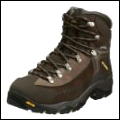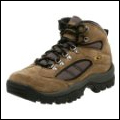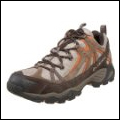|
What Are The Best Hiking Boots?It would be nice to say, "THESE are the best hiking boots!" But it doesn't work that way. The best backpacking boots are what feel comfortable to your feet and suit your backpacking needs. I will say that we personally like Columbia hiking boots But to help you make your own decision, we'll cover tips for choosing hiking boots. The Importance of Finding the Right Backpacking BootsWhen backpacking, your feet are pushed to their limits. Remember, not only will you be walking long distances, you’ll be doing it with extra weight your body isn’t accustomed to. Your feet need proper support. Without the proper footwear, you are much more likely to get blisters and can even put yourself at risk for twisting an ankle. And believe me, having to walk on either of those can be a nightmare. Boot Types
This is your typical backpacking boot. This boot provides good support for your ankles and helps reduce the risk of a twisted ankle. This type of boot is recommended if you are carrying a load that is greater than 40 pounds or backpacking on rough terrain. Additionally, most cold weather boots come in the above the ankle design due to the added support and warmth. It is very important to break in these boots before wearing them on an actual backpacking trip.
This boot is also referred to as a light hiker. It provides some ankle support. These boots tend to fit comfortably from the beginning and require little breaking in. These are the best hiking boots if you are carrying around 20 – 40 pounds and are hiking easy to moderate terrain. This type of boot is preferred by most backpackers as it provides adequate support, but aren't as hot as the above the ankle boot can be.
Also known as trail runners, these boots are basically specialized tennis shoes. They don’t have any ankle support. These shoes are light and can keep the foot cooler than boots (this helps to prevent blisters). Because of this, some backpackers prefer to wear these no matter what the conditions. Generally, this boot is recommended for packs that are approximately 20 pounds or less and hiking on easy terrain. These shoes are easy to break in. Materials When it comes to boots, you can choose between natural and synthetic material. Full-grain leather boots are very water resistant and durable. While synthetic are considered to breathe better. If you are buying leather hiking boots, it is extremely important to properly break them in.
Visit our page on breaking in backpacking hiking boots for more information.
Trying On BootsIn order to find the best hiking boots, it's VERY important to try boots on before you buy them. Even if you want to get a good deal on the internet, you really must be able to see if the boot actually fits. So, here’s how you find the best backpacking boots: Go to an outdoors store. While a regular shoe store might have boots, their supply will be limited and their staff will most likely not have the knowledge of someone who works at a store that specializes in outdoors gear. Another option is to go to a military surplus store. Military boots can make very good hiking boots at an inexpensive price. The leather boots are usually a better choice than the canvas, because leather is more waterproof. Try boots on with your backpacking socks and inserts. These items will make a big difference in how a boot fits compared to just wearing everyday socks.
Check out our page on backpacking socks for more information on getting the right socks.
When you walk around in the boots, you don’t want your feet to move around in them. This causes excess rubbing on your feet, which can lead to blisters. Be sure to test the boots walking up and down an incline to make sure your toes don’t jam into the toe of your shoe or your feet slide.
|








